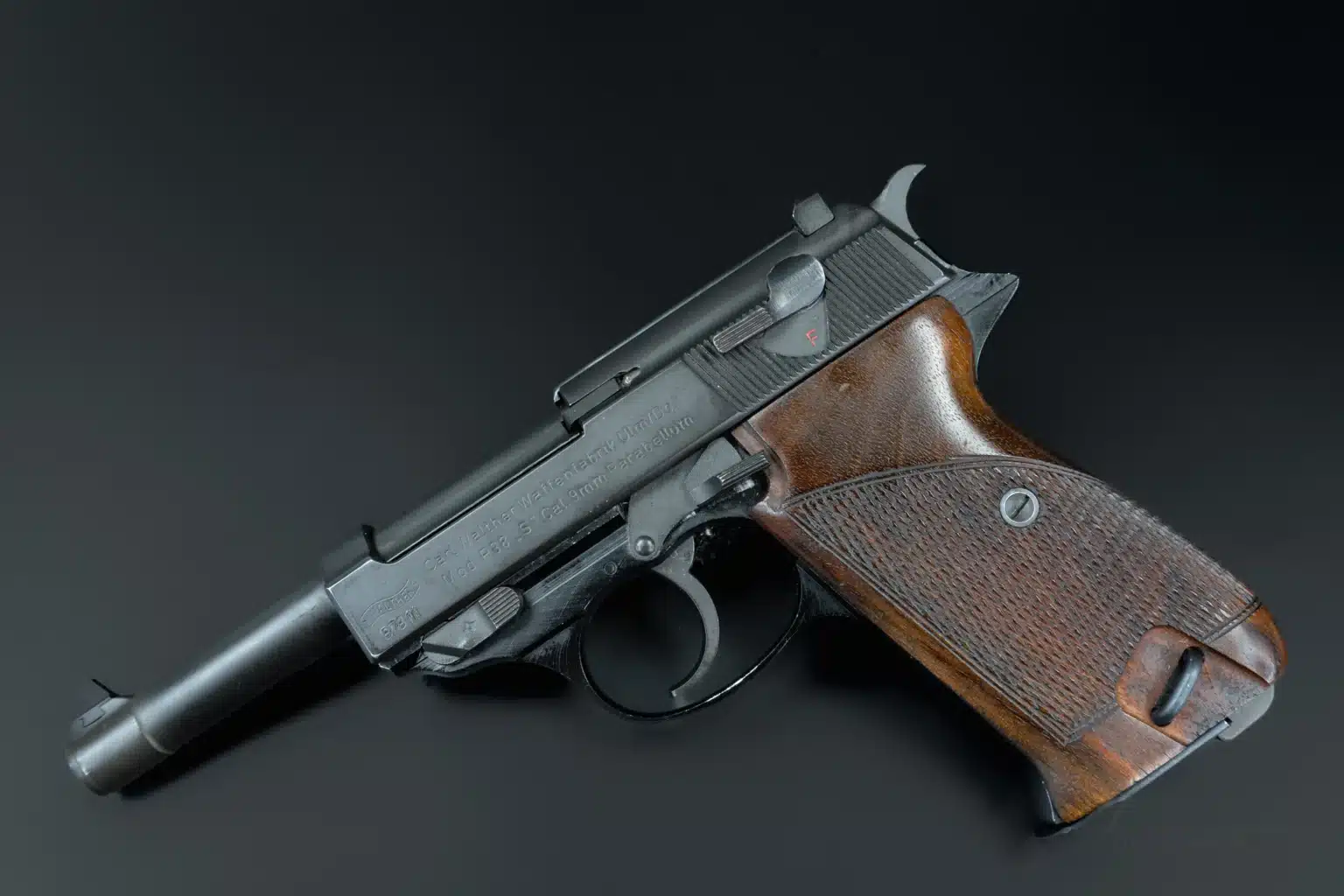The Walther P38, a German semi-automatic pistol, emerged in the late 1930s, marking a significant evolution in handgun design. It was developed to replace the aging Luger P08, the then-standard service pistol of the German army. The P38 was innovative, integrating features like a double-action trigger mechanism, an exposed hammer, and a safer, more reliable locking system. Its conception was driven by the need for a more cost-effective, easier-to-produce, and reliable sidearm. The P38’s design was a response to the complex manufacturing and sensitivity to the dirt of the Luger P08.
The development of this pistol was a milestone in firearms history. It demonstrated an understanding of the practical needs of soldiers in the field, prioritizing reliability and safety. The P38’s influence extended beyond its immediate use in World War II, setting a standard for future military and civilian handguns. The adoption of the P38 by the German army signaled a shift in military pistol design, moving away from the elaborate mechanisms of the past to more practical and robust designs suitable for mass production and rigorous use.
Technological Innovations and Design
The Walther P38 was a pioneer in handgun technology. Its most groundbreaking feature was its double-action trigger mechanism, a first for military sidearms. This mechanism allowed a round to be fired either by a single pull of the trigger (double-action) or by pre-cocking the hammer for a lighter trigger pull (single-action). This feature significantly enhanced the safety and readiness of the weapon, allowing soldiers to carry it with a chambered round without the risk of accidental discharge.
Another innovative aspect of the P38 was its locking mechanism. The P38 employed a falling block instead of the toggle lock system used in the Luger P08, resulting in a more reliable action less prone to malfunctions. This mechanism also contributed to the accuracy and consistency of the pistol. The P38 also featured a loaded chamber indicator, providing a visual and tactile signal to the shooter that the gun was loaded and ready to fire.
The ergonomic design of the P38, with its well-balanced weight and comfortable grip, made it easier to handle and shoot accurately. Its ease of disassembly for cleaning and maintenance was another practical feature that made it well-suited for military use. These design elements set the P38 apart from its contemporaries and influenced future handgun designs.
The P38 in World War II
During World War II, the Walther P38 quickly became a symbol of German military power. It was widely issued to German officers and troops, serving as a reliable tool in the harshest conditions of the battlefield. The P38’s robust design meant it functioned reliably in diverse environments, from the deserts of North Africa to the Eastern Front’s harsh winters.
The pistol’s accuracy and durability made it a favored sidearm among German soldiers, who often preferred it over other handguns. The P38 was also used by various specialized units, including paratroopers and tank crews, who valued its compact size and firepower. Its presence on the battlefield was a testament to its functional design and contributed to its mystique and reputation among both Axis and Allied forces.
The use of the P38 in World War II also had a psychological impact. It symbolized German military efficiency and technological advancement, instilling a sense of pride in German soldiers and intimidation in their adversaries. The P38’s role in various significant battles and war operations further cemented its place in military history.
Post-World War II Influence and Adoption
After the conclusion of World War II, the influence of the Walther P38 extended far beyond Germany. Many countries, recognizing its advanced design and reliability, adopted or were influenced by the P38 for their military and police forces. Notably, the P38 served as the basis for the Beretta M9, which was adopted by the United States military. This adoption signified the P38’s enduring influence on handgun design.
The P38’s post-war popularity was not limited to military use. It also found its way into civilian hands, where its precision, reliability, and historical significance made it a popular choice among collectors and shooting enthusiasts. Law enforcement agencies in various countries also adopted the P38, drawn by its reliability and ease of use.
The continued use and adaptation of the P38’s design elements in modern firearms underscore its lasting impact on handgun technology. Its influence can be seen in the design of many contemporary pistols, particularly in aspects such as the double-action trigger and the emphasis on safety and reliability.
The Walther P38 in Modern Times
Today, the Walther P38 holds a special place in the world of firearms. Collectors and enthusiasts revere it for its historical significance, mechanical innovation, and the role it played in shaping modern handgun design. Its presence in museums and private collections attests to its enduring legacy.
The P38 continues to be featured in films, video games, and literature, often associated with World War II and the German military. This portrayal in popular media has further solidified its status as an iconic firearm, recognized even by those with a passing interest in military history.
Despite the advancements in firearm technology since its inception, the Walther P38 remains a testament to the ingenuity and foresight of its designers. Its design principles continue to influence modern firearm development, and its historical significance ensures that it remains a respected and fascinating chapter in the history of military firearms.
The Enduring Legacy of the Walther P38
The Walther P38 is a monumental piece in the tapestry of firearms history. Its development in the late 1930s marked a significant leap forward in handgun design, combining technological innovation, practical functionality, and reliability in a way that had not been seen before. The P38’s influence extended far beyond its use by the German military during World War II, shaping the future of handgun design for generations to come.
This pistol was not just a tool of war; it was a symbol of the technological advancements of its era and a testament to the ingenuity of its creators. Its double-action trigger mechanism, reliable locking system, and ergonomic design set new standards for military and civilian handguns, influencing numerous subsequent designs, including some of the most widely used pistols in the world.
In the post-war era, the P38’s legacy continued to grow. Its adoption by various military and law enforcement agencies worldwide and its popularity among collectors and shooting enthusiasts speak volumes about its enduring appeal. The P38’s presence in popular culture has further cemented its iconic status, making it one of history’s most recognizable and respected firearms.
As we reflect on the impact of the Walther P38, it is clear that its significance extends beyond its role in conflict. It represents a pivotal moment in the evolution of firearms, demonstrating how innovation, practical design, and an understanding of the user’s needs can come together to create something truly timeless. The Walther P38 remains not just a relic of the past but a continuing source of fascination and respect, a symbol of the enduring nature of quality craftsmanship and innovative design in the world of firearms.



